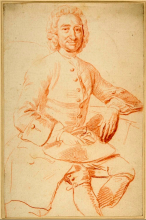George Graham
"Born in the parish of Kirklinton, Cumberland, July 7, 1673, of parents who were members of the Society of Friends. In 1688, he came to London, and was apprenticed to Henry Aske, Clockmaker, July 2 in that year. During his apprenticeship he made the acquaintance of the family of the celebrated Thomas Tompios, Watchmaker, of Fleet Street, who ultimately received him into his employ. He married Elizabeth the daughter of Tompion's brother James, and at his master's decease in November, 1713, succeeded to the business. Made Free of this Company July 2, 1715; chosen one of the Court of Assistants April 2, 1716; Warden 1719-21; Master September 29, 1722. He died November 20, 1751, and was buried by the side of his friend and benefactor, Tompion, in Westminster Abbey. He was acknowledged to be the greatest Horologist of his day, and a most ingenious Mathematical Instrument-maker. In 1715, he applied a compensating power to counteract the effects of heat and cold upon the length of the pendulum. He also invented the repose or dead escapement. In 1724, he greatly improved the horizontal escapement invented by Tompion, and also constructed a great mural arch at the Greenwich Observatory, as well as the sector, by means of which Dr. Bradley first discovered two new motions in the fixed stars. When the French Academicians were sent to the north, to make observations for ascertaining the figure of the earth, Graham was selected to supply them with instruments. The first Planetarium made in England was the work of his genius; it was made for Lord Orrery, whose name has ever since been given in this country to all machines of this description. He was elected a fellow of the Royal Society, March 9, 1720, and communicated to that Society several very important discoveries. He greatly improved the horizontal or cylinder escapement which was used in most of the best watches of his day, while his mercurial pendulum and dead-beat escapement are still used in the best regulators and astronomical timekeepers.
By his will, dated 23rd June, 1747, he left to the poor of the Company, twenty pounds.
The Company have in their Collection a long Eight-day Clock and a Watch-movement of his work, and also his portrait, engraved by Faber, from a painting by T. Hudson."
- Atkins, S. E., & Overall, W. H. (1881). Some Account of the Workshipful Company of Clockmakers of the City of London. London: Prively Printed.pp. 166-67.

